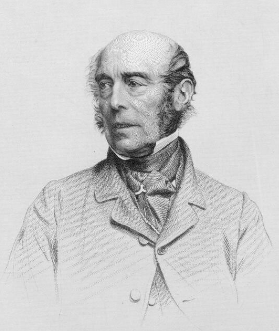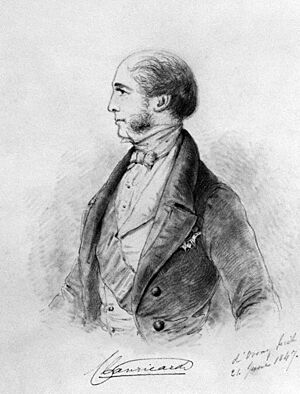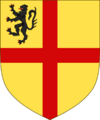Ulick de Burgh, 1st Marquess of Clanricarde facts for kids
Quick facts for kids
The Most Honourable
The Marquess of Clanricarde
|
|||||||||||||
|---|---|---|---|---|---|---|---|---|---|---|---|---|---|

The Marquess of Clanricarde
|
|||||||||||||
| Lord Keeper of the Privy Seal | |||||||||||||
| In office 3 February 1858 – 21 February 1858 |
|||||||||||||
| Monarch | Victoria | ||||||||||||
| Prime Minister | The Viscount Palmerston | ||||||||||||
| Preceded by | The Earl of Harrowby | ||||||||||||
| Succeeded by | The Earl of Hardwicke | ||||||||||||
| Postmaster General | |||||||||||||
| In office 7 July 1846 – 21 February 1852 |
|||||||||||||
| Prime Minister | Lord John Russell | ||||||||||||
| Preceded by | The Earl of St Germans | ||||||||||||
| Succeeded by | The Earl of Hardwicke | ||||||||||||
| British Ambassador to Russia | |||||||||||||
| In office 1838–1840 |
|||||||||||||
| Prime Minister | The Viscount Melbourne | ||||||||||||
| Preceded by | The Earl of Durham | ||||||||||||
| Succeeded by | The Lord Stuart de Rothesay | ||||||||||||
| Captain of the Yeomen of the Guard | |||||||||||||
| In office 1 December 1830 – 16 July 1834 |
|||||||||||||
| Monarch | William IV | ||||||||||||
| Prime Minister | The Earl Grey | ||||||||||||
| Preceded by | The Earl of Macclesfield | ||||||||||||
| Succeeded by | The Earl of Gosford | ||||||||||||
| Under-Secretary of State for Foreign Affairs | |||||||||||||
| In office 2 January 1826 – 17 August 1826 Serving with The Lord Howard de Walden
|
|||||||||||||
| Monarch | George IV | ||||||||||||
| Prime Minister | The Earl of Liverpool | ||||||||||||
| Preceded by |
|
||||||||||||
| Succeeded by | The Lord Howard de Walden | ||||||||||||
|
|||||||||||||
| Personal details | |||||||||||||
| Born |
Ulick John de Burgh
20 December 1802 Belmont, Hampshire |
||||||||||||
| Died | 10 April 1874 (aged 71) Stratton Street, Piccadilly, London |
||||||||||||
| Nationality | British | ||||||||||||
| Political party | |||||||||||||
| Spouse |
Hon. Harriet Canning
(m. 1825) |
||||||||||||
| Children | 7 | ||||||||||||
| Parents |
|
||||||||||||
| Alma mater | Eton College | ||||||||||||
Ulick John de Burgh, 1st Marquess of Clanricarde (born December 20, 1802 – died April 10, 1874) was an important British politician. He held several high-ranking positions during his life. These included being the British Ambassador to Russia from 1838 to 1840, the Postmaster General from 1846 to 1852, and the Lord Keeper of the Privy Seal in 1858.
Contents
Early Life and Education
Ulick John de Burgh was born in Belmont, Hampshire, England. His father was General John de Burgh, 13th Earl of Clanricarde. His mother was Elizabeth, the daughter of Sir Thomas Burke. Ulick became the Earl of Clanricarde in July 1808, when he was only five years old, after his father passed away.
He went to school at Eton College, a famous boarding school. Later, he studied at Christ Church, Oxford University. Like his father, Ulick was a member of the Anglican Church.
Political Career and Important Roles
In 1825, when Ulick was 22, he was given the title Marquess of Clanricarde. This was a very important title in the Peerage of Ireland. The next year, he also became Baron Somerhill in the Peerage of the United Kingdom. This new title allowed him to have a seat in the House of Lords, which is part of the British Parliament.
In 1826, he started his political career as the Parliamentary Under-Secretary of State for Foreign Affairs. This role involved helping with the country's relationships with other nations. He was also made a member of the Privy Council in 1830. This group advises the King or Queen.
From 1838 to 1840, Lord Clanricarde served as the British Ambassador to Russia. This meant he represented Britain in Russia. Later, in 1846, he became the Postmaster General. This job involved managing the postal service. He held this position until 1852. His last government job was briefly as Lord Keeper of the Privy Seal in 1858.
Besides his government roles, he was also the Lord-Lieutenant of County Galway in Ireland. This was a local leadership role he held for many years, from 1831 to 1874. In 1831, he was also honored as a Knight of the Order of St Patrick.
Role During the Great Hunger
Ulick de Burgh owned a lot of land in County Galway, Ireland. His family had lived there for a long time. During the time of the Great Hunger in Ireland (also known as the Irish Potato Famine), he had a mixed record. He was a member of the British government and wanted to protect the interests of landowners like himself.
He did not force huge numbers of his tenants off their land, unlike some other landowners. However, smaller groups of people were displaced over time. As the King's representative in Galway, he did not speak out against other landowners who were known for large-scale evictions.
On the other hand, Ulick de Burgh did try to help. He wrote to the government, explaining how much his starving tenants were suffering. He suggested that the government should get more involved, for example, by creating public work projects or improving land drainage. He also asked for food depots to be set up in towns like Loughrea and Portumna to give out food. He even gave some of his own money to local relief groups.
He also helped some poor tenants move to other countries. This was a difficult decision because it meant people had to leave their homes. However, some believed it was the only way to save lives during the famine. He did not start any private work schemes on his own land for his tenants, unlike some other landlords in the area.
Family Life
Lord Clanricarde married Harriet Canning on April 4, 1825. Harriet was the daughter of George Canning, who later became the Prime Minister of Britain. They had seven children together:
- Lady Elizabeth Joanna de Burgh (1826–1854)
- Ulick Canning de Burgh, Lord Dunkellin (1827–1867)
- Lady Emily Charlotte de Burgh (1828–1912)
- Lady Catherine de Burgh (c. 1830–1895)
- Lady Margaret Anne de Burgh (c. 1831–1888)
- Hubert George de Burgh-Canning, 2nd Marquess of Clanricarde (1832–1916)
- Lady Harriet Augusta de Burgh (c. 1834–1901)
Lord Clanricarde passed away in London in April 1874, at the age of 71. His second son, Hubert, who was his only surviving son, took over his title as Marquess. His wife, the Marchioness of Clanricarde, died in January 1876.
Images for kids



